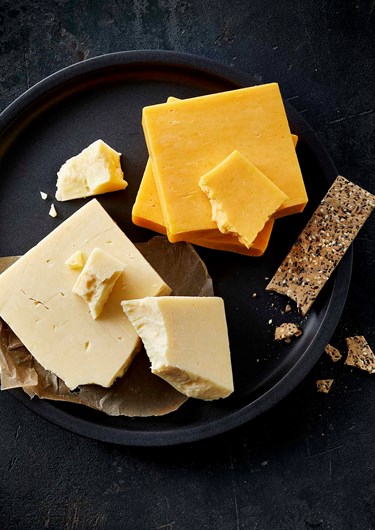
Cheddar
What is Cheddar?
Sprung from the lush dairy pastures of southern England near Wells Cathedral, the legacy of Cheddar spans a diverse range of cultures and cuisines. Bright and mellow, this semi-hard cheese is made from cow’s milk and presents hearty tones of hazelnut and browned butter, often ending in a sharp and lingering finish.
Types of Cheddar
Determined by age, coating, cheese cultures and pasteurisation, varieties of Cheddar differ greatly from each other in terms of both taste and texture. Flavours range from mild to sharp, with the difference coming from the cheese cultures used and the aging of the cheese. Younger cheddars start out mild in flavour, gradually becoming stronger with age. Some Cheddars are added further flavour by way of chilli’s, onions or black pepper.
Partly tradition, partly preference, the orange hue seen in some Cheddars derives from the addition of ground annatto seeds. Annatto, the flavourless fruit from achiote trees found in South America, holds no significant taste or aroma, and has been used in cheeses for generations.
How Cheddar is made
In all aspects, Cheddar boasts immense versatility, meaning that the process of making it has endured many adoptions and variations. Common to all, however, is the process known as Cheddaring, in which loaves of curd are stacked on top of one another, causing excess whey to drain off. It is during this continual layering that the cheese begins to develop its characteristic flavour and texture.
Depending on the type of Cheddar, aging will take a minimum of 2 months and up to 2 years for extra mature cheese. During this period, the texture goes from smooth to crumbly, while flavours take on notes of hazelnut, and sharpen in aftertaste.
With annatto as the only real additive, Cheddar is clean in flavour and contains no preservatives or fillers, making it gluten free. Young Cheddars are often pasteurised, while aged variants sometimes are unpasteurised to encourage salt crystals to form. Using either animal or vegetable rennet, the production of Cheddar allows for both vegetarian and non-vegetarian variants.
Cooking with Cheddar
When cooking with Cheddar, thin slices provide an even coating, and ensure that all parts of the dish are covered. As a topping for baked dishes, the cheese turns crispy and golden in the oven, while a soft and stringy consistency develops when exposed to heat.
Grated cheese is best for quick and easy melting. For a satisfyingly crunchy texture, grated cheese will deliver the best results.
Storing Cheddar
Cheddar enjoys a long lifespan, especially when stored under the proper conditions. Once opened, a block can last 3-4 weeks in a refrigerator, whereas it can stay fresh for up to 6 months unopened. Although the crumbly and flaky texture suffers when subjected to the freezer, most Cheddar can survive 6-8 months of being frozen.
Substitutes for Cheddar
Finding the right substitute involves looking at the characteristics of the Cheddar that you want to replace.
An aged Gouda closely matches the qualities of many sharper, aged Cheddars. With a deep aroma of hazelnuts, the body is crumbly, with a rich and salty flavour.

Explore Castello Cheddar
Find your favourite Castello Cheddar now
Curious about the world of cheese? Here's everything you need to know about how to store, serve and cut cheese!

Discover our cheeses
A world of surprising and indulgent sensations









